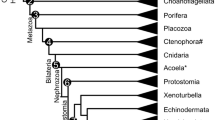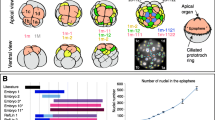Abstract
Differences in brain structure between species have long fascinated evolutionary biologists. Understanding how these differences arise requires knowing how they are generated in the embryo. Growing evidence in the field of evolutionary developmental biology (evo-devo) suggests that morphological differences between species result largely from changes in the spatiotemporal regulation of gene expression during development. Corresponding changes in functional cellular behaviors (morphogenetic mechanisms) are only beginning to be explored, however. Here we show that spatiotemporal patterns of tissue contractility are sufficient to explain differences in morphology of the early embryonic brain between disparate species. We found that enhancing cytoskeletal contraction in the embryonic chick brain with calyculin A alters the distribution of contractile proteins on the apical side of the neuroepithelium and changes relatively round cross-sections of the tubular brain into shapes resembling triangles, diamonds, and narrow slits. These perturbed shapes, as well as overall brain morphology, are remarkably similar to those of corresponding sections normally found in species such as zebrafish and Xenopus laevis (frog). Tissue staining revealed relatively strong concentration of F-actin at vertices of hyper-contracted cross-sections, and a finite element model shows that local contraction in these regions can convert circular sections into the observed shapes. Another model suggests that these variations in contractility depend on the initial geometry of the brain tube, as localized contraction may be needed to open the initially closed lumen in normal zebrafish and Xenopus brains, whereas this contractile machinery is not necessary in chick brains, which are already open when first created. We conclude that interspecies differences in cytoskeletal contraction may play a larger role in generating differences in morphology, and at much earlier developmental stages, in the brain than previously appreciated. This study is a step toward uncovering the underlying morphomechanical mechanisms that regulate how neural phenotypic differences arise between species.
Similar content being viewed by others
References
Barton RA, Harvey PH (2000) Mosaic evolution of brain structure in mammals. Nature 405(6790): 1055–1058
Breuker CJ, Debat V, Klingenberg CP (2006) Functional evo-devo. Trends Ecol Evol 21(9): 488–492
Carroll SB (2008) Evo-devo and an expanding evolutionary synthesis: a genetic theory of morphological evolution. Cell 134(1): 25–36
Copp AJ, Greene ND, Murdoch JN (2003) The genetic basis of mammalian neurulation. Nat Rev Genet 4(10): 784–793
Desmond ME, Jacobson AG (1977) Embryonic brain enlargement requires cerebrospinal fluid pressure. Dev Biol 57(1): 188–198
Desmond ME, Levitan ML, Haas AR (2005) Internal luminal pressure during early chick embryonic brain growth: descriptive and empirical observations. Anat Rec A Discov Mol Cell Evol Biol 285(2): 737–747
Dye NA, Pincus Z, Theriot JA, Shapiro L, Gitai Z (2005) Two independent spiral structures control cell shape in Caulobacter. Proc Natl Acad Sci USA 102(51): 18608–18613
Ettensohn CA (1985) Mechanisms of epithelial invagination. Q Rev Biol 60: 289–307
Fabian L, Troscianczuk J, Forer A (2007) Calyculin A, an enhancer of myosin, speeds up anaphase chromosome movement. Cell Chromosom 6: 1
Filas BA, Bayly PV, Taber LA (2011) Mechanical stress as a regulator of cytoskeletal contractility and nuclear shape in embryonic epithelia. Ann Biomed Eng 39(1): 443–454
Gato A, Desmond ME (2009) Why the embryo still matters: CSF and the neuroepithelium as interdependent regulators of embryonic brain growth, morphogenesis and histiogenesis. Dev Biol 327(2): 263–272
Gutzman JH, Graeden EG, Lowery LA, Holley HS, Sive H (2008) Formation of the zebrafish midbrain-hindbrain boundary constriction requires laminin-dependent basal constriction. Mech Dev 125 (11–12): 974–983
Gutzman JH, Sive H (2010) Epithelial relaxation mediated by the myosin phosphatase regulator Mypt1 is required for brain ventricle lumen expansion and hindbrain morphogenesis. Development 137(5): 795–804
Hamburger V, Hamilton HL (1951) A series of normal stages in the development of the chick embryo. J Morphol 88: 49–92
Harrington MJ, Hong E, Brewster R (2009) Comparative analysis of neurulation: first impressions do not count. Mol Reprod Dev 76(10): 954–965
Hofman MA (1989) On the evolution and geometry of the brain in mammals. Prog Neurobiol 32(2): 137–158
Hofmann HA (2010) Early developmental patterning sets the stage for brain evolution. Proc Natl Acad Sci USA 107(22): 9919–9920
Kinoshita N, Sasai N, Misaki K, Yonemura S (2008) Apical accumulation of Rho in the neural plate is important for neural plate cell shape change and neural tube formation. Mol Biol Cell 19(5): 2289–2299
Koshiba-Takeuchi K, Mori AD, Kaynak BL, Cebra-Thomas J, Sukonnik T, Georges RO, Latham S, Beck L, Henkelman RM, Black BL, Olson EN, Wade J, Takeuchi JK, Nemer M, Gilbert SF, Bruneau BG (2009) Reptilian heart development and the molecular basis of cardiac chamber evolution. Nature 461(7260): 95–98
Lee HY, Nagele RG (1985) Studies on the mechanisms of neurulation in the chick: interrelationship of contractile proteins, microfilaments, and the shape of neuroepithelial cells. J Exp Zool 235(2): 205–215
Lowery LA, Sive H (2004) Strategies of vertebrate neurulation and a re-evaluation of teleost neural tube formation. Mech Dev 121(10): 1189–1197
Lowery LA, Sive H (2005) Initial formation of zebrafish brain ventricles occurs independently of circulation and requires the nagie oko and snakehead/atp1a1a.1 gene products. Development 132(9): 2057–2067
Lui JH, Hansen DV, Kriegstein AR (2011) Development and evolution of the human neocortex. Cell 146(1): 18–36
Manner J, Seidl W, Steding G (1993) Correlation between the embryonic head flexures and cardiac development. Anat Embryol 188: 269–285
Martin AC (2010) Pulsation and stabilization: contractile forces that underlie morphogenesis. Dev Biol 341(1): 114–125
Martin AC, Kaschube M, Wieschaus EF (2009) Pulsed contractions of an actin-myosin network drive apical constriction. Nature 457(7228): 495–499
McGowan L, Kuo E, Martin A, Monuki ES, Striedter G (2011) Species differences in early patterning of the avian brain. Evolution 65(3): 907–911
Nelson CM, Jean RP, Tan JL, Liu WF, Sniadecki NJ, Spector AA, Chen CS (2005) Emergent patterns of growth controlled by multicellular form and mechanics. Proc Natl Acad Sci USA 102(33): 11594–11599
Nerurkar NL, Ramasubramanian A, Taber LA (2006) Morphogenetic adaptation of the looping embryonic heart to altered mechanical loads. Dev Dyn 235(7): 1822–1829
Nieuwkoop PD, Faber J (1967) Normal tables of Xenopus laevis (Daudin). Elsevier/North-Holland Biomedical Press, Amsterdam
Northcutt RG (2001) Changing views of brain evolution. Brain Res Bull 55(6): 663–674
Nyholm MK, Abdelilah-Seyfried S, Grinblat Y (2009) A novel genetic mechanism regulates dorsolateral hinge-point formation during zebrafish cranial neurulation. J Cell Sci 122(Pt12): 2137–2148
Olson EN (2006) Gene regulatory networks in the evolution and development of the heart. Science 313(5795): 1922–1927
Pincus Z, Theriot JA (2007) Comparison of quantitative methods for cell-shape analysis. J Microsc 227(Pt2): 140–156
Raghavan S, Shen CJ, Desai RA, Sniadecki NJ, Nelson CM, Chen CS (2010) Decoupling diffusional from dimensional control of signaling in 3D culture reveals a role for myosin in tubulogenesis. J Cell Sci 123(Pt17): 2877–2883
Rodriguez EK, Hoger A, McCulloch AD (1994) Stress-dependent finite growth in soft elastic tissues. J Biomech 27: 455–467
Salazar-Ciudad I, Jernvall J (2010) A computational model of teeth and the developmental origins of morphological variation. Nature 464(7288): 583–586
Salazar-Ciudad I, Jernvall J, Newman SA (2003) Mechanisms of pattern formation in development and evolution. Development 130(10): 2027–2037
Schoenwolf GC, Smith JL (1990) Mechanisms of neurulation: traditional viewpoint and recent advances. Development 109: 243–270
Solon J, Kaya-Copur A, Colombelli J, Brunner D (2009) Pulsed forces timed by a ratchet-like mechanism drive directed tissue movement during dorsal closure. Cell 137(7): 1331–1342
Sylvester JB, Rich CA, Loh YH, van Staaden MJ, Fraser GJ, Streelman JT (2010) Brain diversity evolves via differences in patterning. Proc Natl Acad Sci USA 107(21): 9718–9723
Taber LA (2004) Nonlinear theory of elasticity: applications in biomechanics. World Scientific, New Jersey
Taber LA (2008) Theoretical study of Beloussov’s hyper-restoration hypothesis for mechanical regulation of morphogenesis. Biomech Model Mechanobiol 7: 427–441
Voronov DA, Taber LA (2002) Cardiac looping in experimental conditions: the effects of extraembryonic forces. Dev Dyn 224: 413–421
Welker W, Jones EG, Peters A (1990) Why does the cerebral cortex fissure and fold? A review of the determinants of gyri and sulci. In: Cerebral cortex. Plenum, New York, pp 3–136
Wozniak MA, Chen CS (2009) Mechanotransduction in development: a growing role for contractility. Nat Rev Mol Cell Biol 10(1): 34–43
Xu G, Kemp PS, Hwu JA, Beagley AM, Bayly PV, Taber LA (2010) Opening angles and material properties of the early embryonic chick brain. J Biomech Eng 132(1): 011005
Author information
Authors and Affiliations
Corresponding author
Electronic Supplementary Material
The Below is the Electronic Supplementary Material.
Rights and permissions
About this article
Cite this article
Filas, B.A., Oltean, A., Beebe, D.C. et al. A potential role for differential contractility in early brain development and evolution. Biomech Model Mechanobiol 11, 1251–1262 (2012). https://doi.org/10.1007/s10237-012-0389-4
Received:
Accepted:
Published:
Issue Date:
DOI: https://doi.org/10.1007/s10237-012-0389-4




